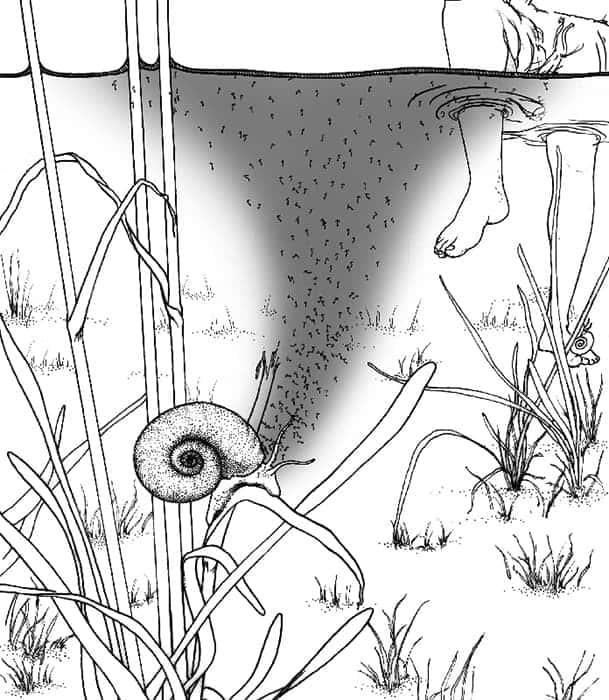
The parasite that causes the tropical disease schistosomiasis exploits a unique elasto-hydrodynamic coupling that allows it to swim extremely efficiently, according to a team of researchers in the US. The parasite’s larva relies on being a good swimmer to infect humans, so the team hopes that its findings will lead to interventions that hinder its movement and reduce infections.
Schistosomiasis is a parasitic disease caused by blood flukes of the genus Schistosoma. According to the World Health Organization, an estimated 258 million people, mainly in Africa, required treatment for the disease in 2014, although only 20 per cent of those received it. Like most neglected tropical diseases, schistosomiasis mainly affects people living in poverty.
Infections occur when people enter water that contains the free-swimming larval stage of the parasite, which is released by freshwater snails. The larvae look for humans, pierce their skin and then migrate to blood vessels where they develop into adults. Adult females then release eggs that either pass out of the body – in faeces or urine – and infect snail hosts or become trapped in body tissue, causing disease.
Poverty trap
Common symptoms of schistosomiasis include abdominal pain, diarrhoea and blood in stools and urine. It has a significant economic impact because chronic infection can affect people’s ability to work, trapping families in poverty, and childhood disease can impact learning, as well as causing anaemia and stunted growth. An estimated 20,000 people die every year as a result of schistosomiasis. Although treatment is available, people are often re-infected because they cannot avoid contact with contaminated water.
The larvae only have 12 h to find a human – or else they perish, because they cannot feed
Grace Presley
Manu Prakash, a bioengineer at Stanford University, told Physics World that once the larvae leave a snail “they only have 12 h to find a human – or else they perish, because they cannot feed”. “This insight told us that swimming efficiency and mechanisms must be important for the disease infection cycle.” To help them understand how the parasite larvae swim, Prakash and his colleagues studied live specimens using high-speed cameras that collected up to 2000 frames per second, and built mathematical and robotic models of the larvae.
The larvae are around 500 μm long and have a head and a slender tail that splits into a two-pronged fork at the end. This unusual fork is not seen in any other well-studied swimming micro-organisms. The researchers identified three different swimming gaits, each with different positioning of the fork. The most significant of these was a tail-first technique that the parasites used to swim upward against gravity, to get them closer to the water’s surface where they are more likely to find a human host. For most of this stroke, the fork sits perpendicular to the rest of the tail, creating a “T” shape.
Symmetry breaking
Because of its small size, the parasite is a low Reynolds-number swimmer, which means that viscous forces dominate its motion and inertial forces are not important. When the researchers studied the “T-swimming” technique, they discovered that the parasite uses an unusual method to break time-reversal symmetry.
During this gait the larvae beat their tails from side-to-side, while maintaining an increased flexibility at the joint at each end. According to the researchers, this creates an unusual elasto-hydrodynamic effect “where the tail provides the energy for propulsion but no thrust, while tail-head and tail-fork joints act as passive torsional springs providing all the thrust”. Prakash explains that the “tail acts as a torsional elastic joint” and there is an elasto-hydrodynamic coupling with “the elasticity of this torsional spring balancing the hydrodynamic drag force that acts on the fork”.
Low-energy mechanism
This creates a very simplistic, low-energy mechanism where the only control comes from tuning the flexibility of the joints. The mathematical models and robot larvae that the team built show that the joint stiffness ratios used by the parasite larvae provide the most efficient swimming stroke possible.
Prakesh told Physics World that his team is now looking to exploit its understanding of the larva’s swimming technique to tackle schistosomiasis transmission. Indeed, the researchers have just returned from a field trip where they were looking at how the parasite larvae swim and find hosts in open-water bodies. The research is described in Nature Physics.



